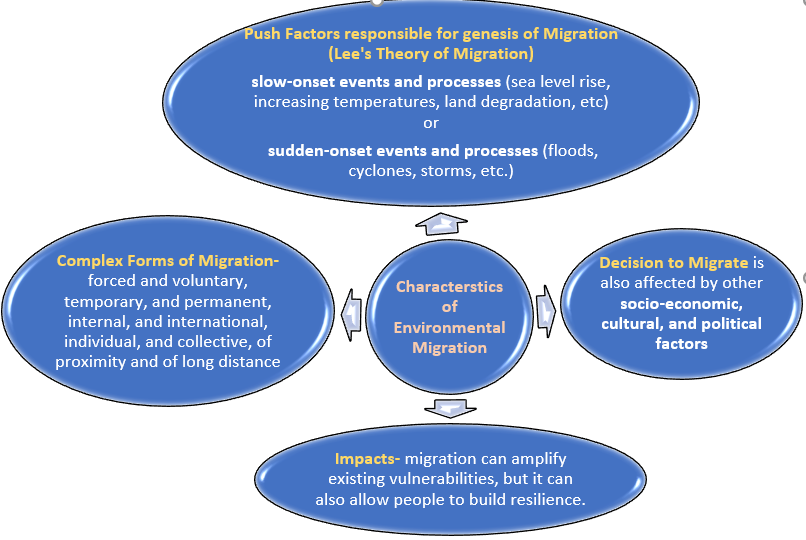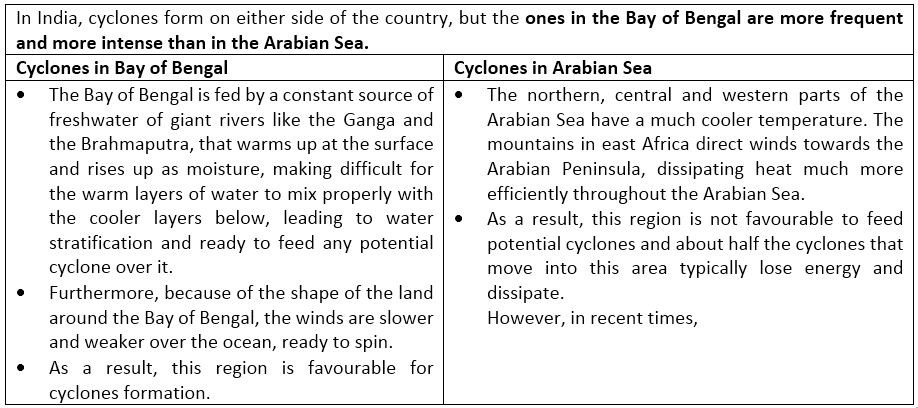03 Jul
Changing demographic attributes across the world
In News
Recently China relaxed its two-child policy to three after a census showed its population is rapidly ageing. This decision of China presents a larger picture of the current trends of demographic transition and changing demographic attributes across the world.
Current Demographic Trends and Patterns
The demographic transition has swept the world since the end of the nineteenth century. The unprecedented increase in population growth during the Post-Malthusian Regime has been ultimately reversed, bringing about significant reductions in fertility rates and population growth in various regions of the world.
The World Population Prospects (WPP) 2019 Report describes two demographic megatrends (population growth and ageing), as well as key trends in human fertility, mortality, and net international migration that are integral to sustainable development.
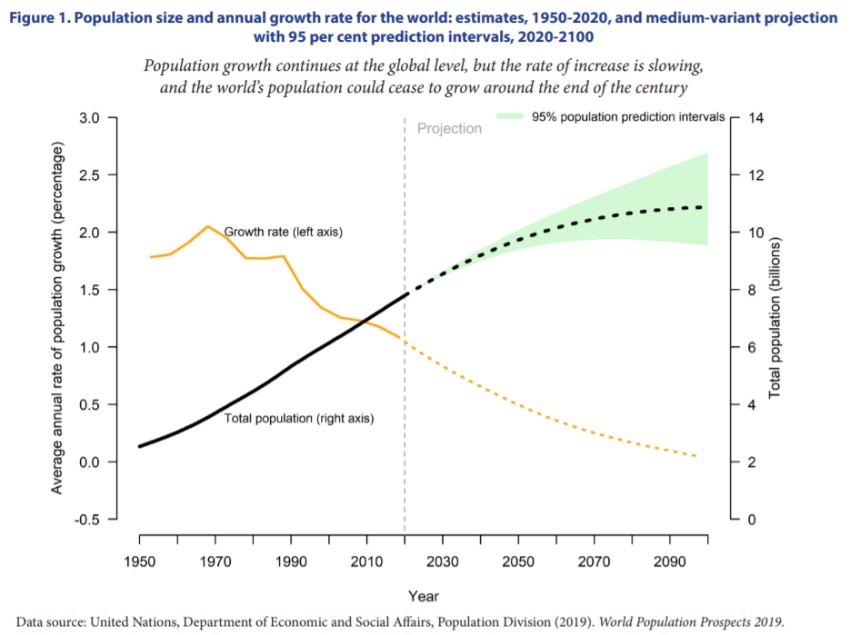
According to WPP, 2019 Report
- Population Growth Trends: World’s population is projected to grow from7 billion in 2019 to 8.5 billion in 2030 (10% increase), and further to 9.7 billion in 2050 (26%) and to 10.9 billion in 2100 (42%).
- Regional Pattern of Projected Growth:
- The population of sub-Saharan Africa is projected to double by 2050. This is reflective of this region being in Stage II of Demographic Transition Model (DTM).
- More than half of the projected increase in the global population to 2050 will be concentrated in just nine countries- India, Nigeria, Pakistan, Democratic Republic of the Congo, Ethiopia, the United Republic of Tanzania, Indonesia, Egypt and the United States of America.
- Current projections indicate that India will surpass China as the world’s most populous country around 2027.
- Drivers of future Population Growth: Two-thirds of the projected growth of the global population through 2050 will be driven by current age structures. The implication of the current population age structure for future population growth is called “population momentum”.
- Regional Trend and Pattern of Fertility: Close to half of all people globally live in a country or area where fertility is below 2.1 births per woman over a lifetime. The global fertility rate, which fell from 3.2 births per woman in 1990 to 2.5 in 2019, is projected to decline further to 2.2 in 2050.
- Regional Trends and Pattern of Life Expectancy: Life expectancy at birth for the world, which increased from 64.2 years in 1990 to 72.6 years in 2019, is expected to increase further to 77.1 years in 2050. However, in 2019, life expectancy at birth in the least developed countries lags 7.4 years behind the global average, due largely to persistently high child and maternal mortality, as well as violence, conflict, and the continuing impact of the HIV epidemic.
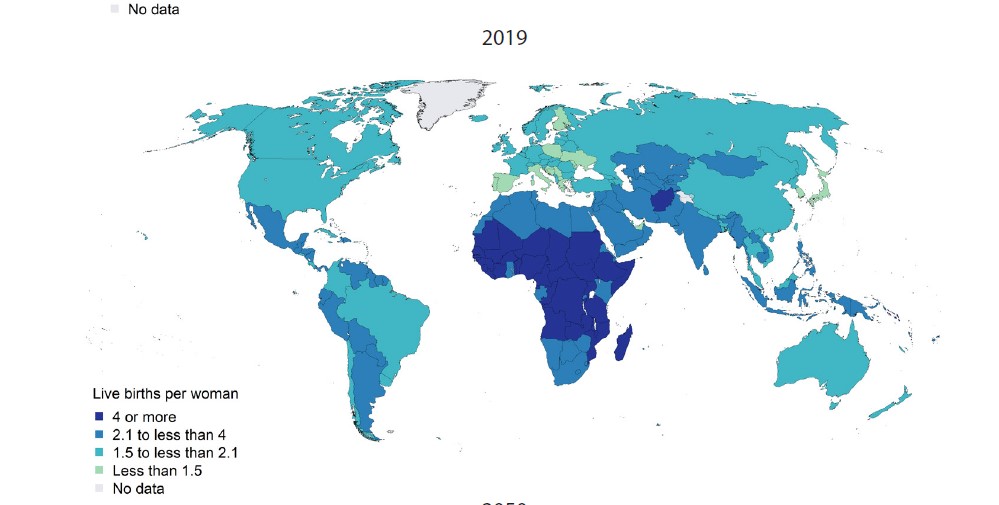
- Ageing Population (Characteristic of DTM Stage IV and V)- Trends and Patterns:
- Population aging is the dominant demographic trend of the twenty-first century—a reflection of increasing longevity, declining fertility, and the progression of large cohorts to older ages.
- The world’s population is growing older, with persons over age 65 being the fastest-growing age group. By 2050, 16% of the world population will be over age 65 up from 9% in 2019. In 2018, for the first time in history, persons aged 65 or above outnumbered children under five years of age.
- Japan is currently the world leader, with 28% of its population 65 and over, triple the world average.
- The number of persons aged 80 years or over is projected to triple, from 143 million in 2019 to 426 million in 2050.

It is clear from the findings of WPP 2019 that various regions across the world are experiencing different stages of demographic transition as described by the Demographic Transition Model (DTM). The following graph depicts the DTM along with examples of various regions under various stages of DTM.
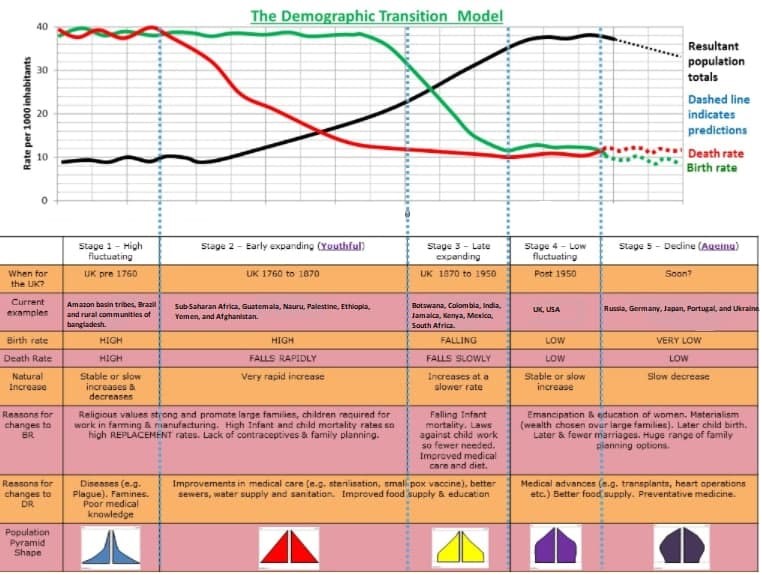
Implications of Current Trends in Demographic Attributes
- Implications of increasing Life Expectancy:
- It is leading to ageing of population across the world. Population ageing will have a profound effect on the potential support ratio (PSR), defined as the number of people of working age (25 to 64 years) per person aged 65 years or over. At 8, Japan in 2019 has the lowest potential support ratio in the world.
- Old-age poverty is likely to be a growing concern as demographic change continues. In 2018, in the EU countries, 15.5% of people aged 65 or above were at risk of poverty. Women are more likely to be affected by old-age poverty.
- Implications of Low Fertility:
- Low fertility once set in persists longer as described by Arsene Dumont in his Social Capillarity Concept. According to it, large families are disincentives for desire of people to rise up in economic and social hierarchy.

- Impact on Job Market: More immediate impact of low fertility is shrinking labour forces. Europe, Japan, and the United States are on the list, but China’s labor market is shrinking faster than Japan due to excessively low fertility of 1.3 which is attributed to strict family planning regime (one child policy) of over four decades.
- Threats of Depopulation:
- A growing number of countries are experiencing a reduction in population size (DTM Stage-V). This is mostly because of persistent low fertility but, high mortality due to more people dying in old age. Examples include Japan, which recorded 2.6 million more deaths than births from 2010 to 2019, and Ukraine, where deaths exceeded births by close to 2.3 million over that period.
- In some cases, it is also attributed to high rates of emigration and mortality risk associated with conflicts. The largest decline was observed in the Syrian Arab Republic, where the population in 2019 is 20% smaller than in 2010, due to the outflow of refugees and heightened mortality risks associated with the conflict there.
- Demographic Dividend: While some areas like Europe and North America are experiencing ageing of population, there are regions and countries (Sub-Saharan Africa, India, Countries in Latin America) having largest share in working age group (25-64 years). The “demographic dividend” refers to the process through which a changing age structure can spur economic growth. It depends, of course, on several complex factors, including the nature and pace of demographic change, the operation of labor and capital markets, macroeconomic management and trade policies, governance, and human capital accumulation.
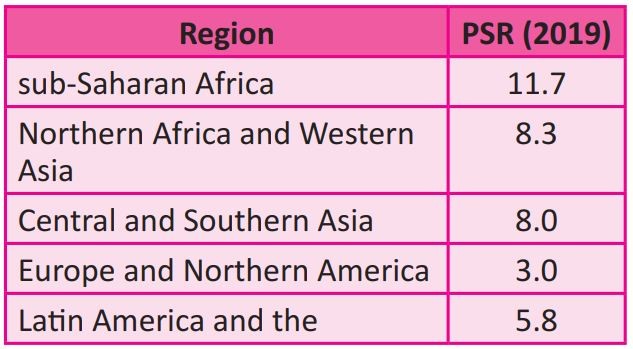
- In this context, efforts to achieve the Sustainable Development Goals – such as ending hunger, ensuring healthy lives, promoting education and life-long learning, creating jobs, improving social protection, and reducing inequality – can reinforce these trends and lead to greater opportunities.
- The dependency ratio: The inverse of the working age to non-working-age ratio—measures the economic pressure working-age individuals face to support, in addition to themselves, those who are not of working age. By 2020, as a result of different patterns of fertility decline and population aging, the ratio had increased to 0.70 in more developed regions and decreased to 0.75 in less developed regions from 1990. This switch suggests that in the coming decades, demographics will be more favourable to economic well-being in less developed regions than in more developed regions. This will be especially true in Africa, the only region in which this ratio is projected to decline by 2050.

- Migratory Trends: Migration can attenuate decreasing population size in countries where the number of deaths exceeds the number of births.
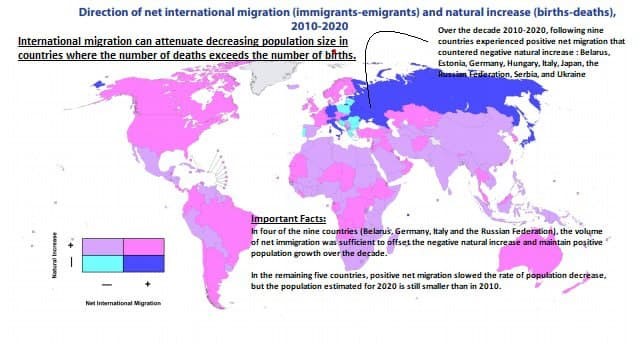
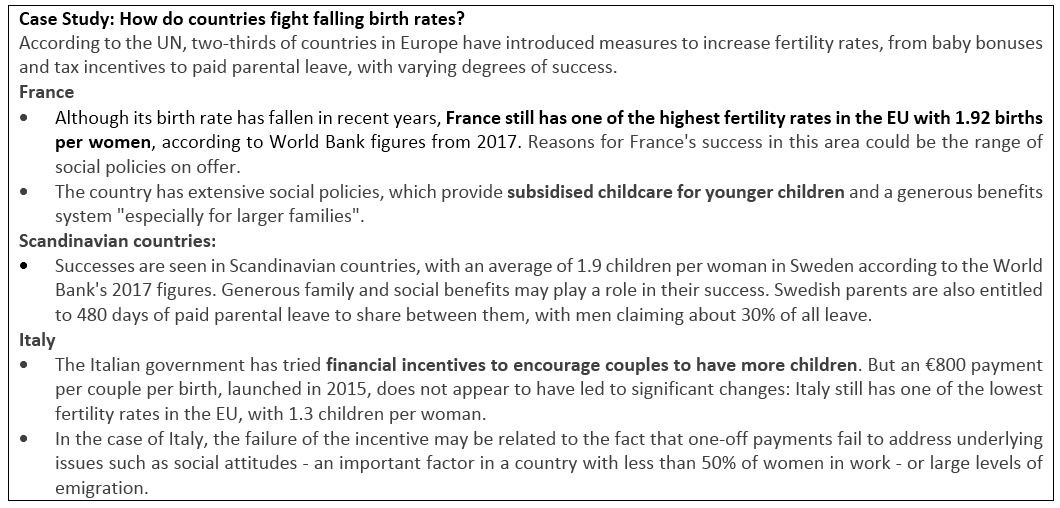
The emerging “silver-economy” can provide opportunities for the health and long-term care sectors. It can be a driver of innovation to help provide high-quality care services in a more efficient way. Digitalisation can provide elderly people with the possibility to independently monitor their health condition. The impact of digital technologies in health and long-term care can be a triple win: improved quality of life, increased efficiency of health and long-term care, market growth and industry development. Research and innovation will be crucial in this regard.
Where it can be used:
Paper1 - Population geography (demographic attributes, Causes and consequences of migration) human development index.
Paper2- Cultural setting (demographic attributes)
Tags: UPSC, Geography, Optional, Population Geography, Demographic attributes, Silver Economy, Two-child policy
Sources:
- 1) The 2019 Revision of World Population Prospects
- 2) Changing Global Demographics: The Certain Future
- 3) European Commission Report on the Impact of Demographic Change
- 4) Demographics can be a potent driver of the pace and process of economic development
- 5) Human population growth and the demographic transition
Changing demographic attributes across the world
In News
Recently China relaxed its two-child policy to three after a census showed its population is rapidly ageing. This decision of China presents a larger picture of the current trends of demographic transition and changing demographic attributes across the world.
Current Demographic Trends and Patterns
The demographic transition has swept the world since the end of the nineteenth century. The unprecedented increase in population growth during the Post-Malthusian Regime has been ultimately reversed, bringing about significant reductions in fertility rates and population growth in various regions of the world.
The World Population Prospects (WPP) 2019 Report describes two demographic megatrends (population growth and ageing), as well as key trends in human fertility, mortality, and net international migration that are integral to sustainable development.
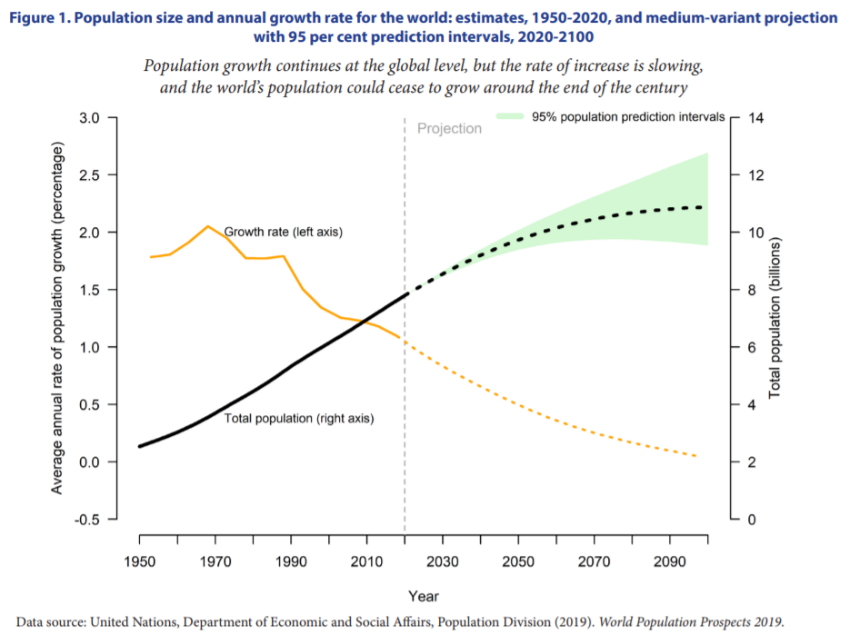
According to WPP, 2019 Report
- Population Growth Trends: World’s population is projected to grow from7 billion in 2019 to 8.5 billion in 2030 (10% increase), and further to 9.7 billion in 2050 (26%) and to 10.9 billion in 2100 (42%).
- Regional Pattern of Projected Growth:
- The population of sub-Saharan Africa is projected to double by 2050. This is reflective of this region being in Stage II of Demographic Transition Model (DTM).
- More than half of the projected increase in the global population to 2050 will be concentrated in just nine countries- India, Nigeria, Pakistan, Democratic Republic of the Congo, Ethiopia, the United Republic of Tanzania, Indonesia, Egypt and the United States of America.
- Current projections indicate that India will surpass China as the world’s most populous country around 2027.
- Drivers of future Population Growth: Two-thirds of the projected growth of the global population through 2050 will be driven by current age structures. The implication of the current population age structure for future population growth is called “population momentum”.
- Regional Trend and Pattern of Fertility: Close to half of all people globally live in a country or area where fertility is below 2.1 births per woman over a lifetime. The global fertility rate, which fell from 3.2 births per woman in 1990 to 2.5 in 2019, is projected to decline further to 2.2 in 2050.
- Regional Trends and Pattern of Life Expectancy: Life expectancy at birth for the world, which increased from 64.2 years in 1990 to 72.6 years in 2019, is expected to increase further to 77.1 years in 2050. However, in 2019, life expectancy at birth in the least developed countries lags 7.4 years behind the global average, due largely to persistently high child and maternal mortality, as well as violence, conflict, and the continuing impact of the HIV epidemic.

- Ageing Population (Characteristic of DTM Stage IV and V)- Trends and Patterns:
- Population aging is the dominant demographic trend of the twenty-first century—a reflection of increasing longevity, declining fertility, and the progression of large cohorts to older ages.
- The world’s population is growing older, with persons over age 65 being the fastest-growing age group. By 2050, 16% of the world population will be over age 65 up from 9% in 2019. In 2018, for the first time in history, persons aged 65 or above outnumbered children under five years of age.
- Japan is currently the world leader, with 28% of its population 65 and over, triple the world average.
- The number of persons aged 80 years or over is projected to triple, from 143 million in 2019 to 426 million in 2050.
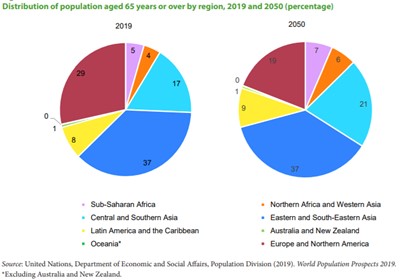
It is clear from the findings of WPP 2019 that various regions across the world are experiencing different stages of demographic transition as described by the Demographic Transition Model (DTM). The following graph depicts the DTM along with examples of various regions under various stages of DTM.
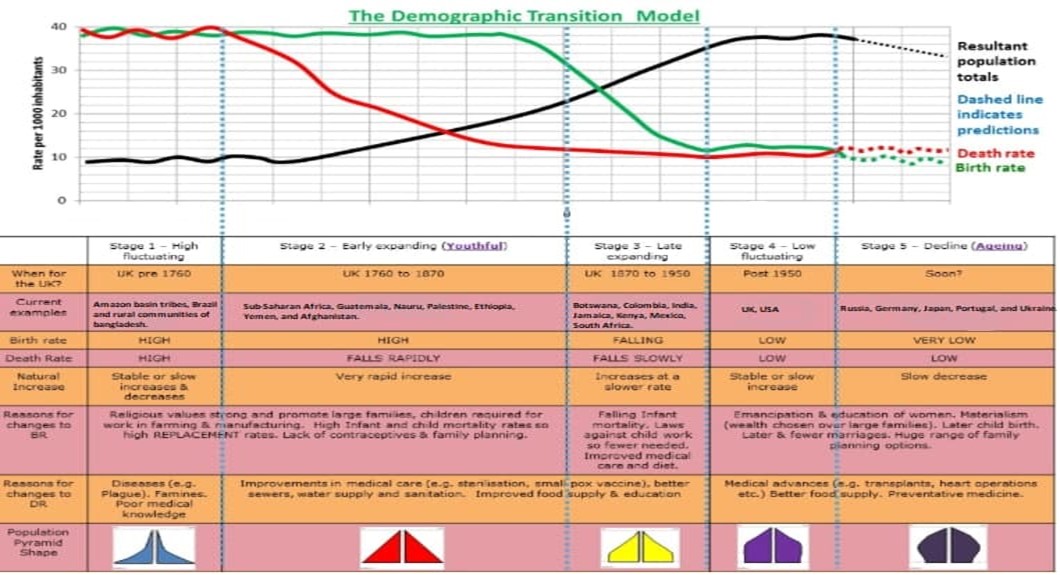
Implications of Current Trends in Demographic Attributes
- Implications of increasing Life Expectancy:
- It is leading to ageing of population across the world. Population ageing will have a profound effect on the potential support ratio (PSR), defined as the number of people of working age (25 to 64 years) per person aged 65 years or over. At 8, Japan in 2019 has the lowest potential support ratio in the world.
- Old-age poverty is likely to be a growing concern as demographic change continues. In 2018, in the EU countries, 15.5% of people aged 65 or above were at risk of poverty. Women are more likely to be affected by old-age poverty.
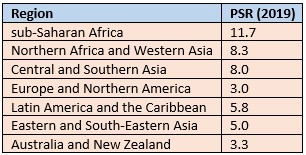
- Implications of Low Fertility:
- Low fertility once set in persists longer as described by Arsene Dumont in his Social Capillarity Concept. According to it, large families are disincentives for desire of people to rise up in economic and social hierarchy.
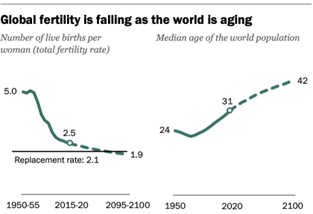
- Impact on Job Market: More immediate impact of low fertility is shrinking labour forces. Europe, Japan, and the United States are on the list, but China’s labor market is shrinking faster than Japan due to excessively low fertility of 1.3 which is attributed to strict family planning regime (one child policy) of over four decades.
- Threats of Depopulation:
- A growing number of countries are experiencing a reduction in population size (DTM Stage-V). This is mostly because of persistent low fertility but, high mortality due to more people dying in old age. Examples include Japan, which recorded 2.6 million more deaths than births from 2010 to 2019, and Ukraine, where deaths exceeded births by close to 2.3 million over that period.
- In some cases, it is also attributed to high rates of emigration and mortality risk associated with conflicts. The largest decline was observed in the Syrian Arab Republic, where the population in 2019 is 20% smaller than in 2010, due to the outflow of refugees and heightened mortality risks associated with the conflict there.
- Demographic Dividend: While some areas like Europe and North America are experiencing ageing of population, there are regions and countries (Sub-Saharan Africa, India, Countries in Latin America) having largest share in working age group (25-64 years). The “demographic dividend” refers to the process through which a changing age structure can spur economic growth. It depends, of course, on several complex factors, including the nature and pace of demographic change, the operation of labor and capital markets, macroeconomic management and trade policies, governance, and human capital accumulation.
- In this context, efforts to achieve the Sustainable Development Goals – such as ending hunger, ensuring healthy lives, promoting education and life-long learning, creating jobs, improving social protection, and reducing inequality – can reinforce these trends and lead to greater opportunities.
- The dependency ratio: The inverse of the working age to non-working-age ratio—measures the economic pressure working-age individuals face to support, in addition to themselves, those who are not of working age. By 2020, as a result of different patterns of fertility decline and population aging, the ratio had increased to 0.70 in more developed regions and decreased to 0.75 in less developed regions from 1990. This switch suggests that in the coming decades, demographics will be more favourable to economic well-being in less developed regions than in more developed regions. This will be especially true in Africa, the only region in which this ratio is projected to decline by 2050.

- Migratory Trends: Migration can attenuate decreasing population size in countries where the number of deaths exceeds the number of births.
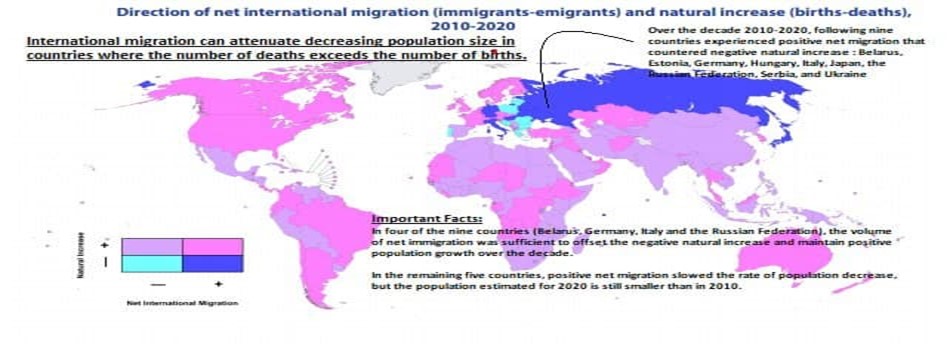
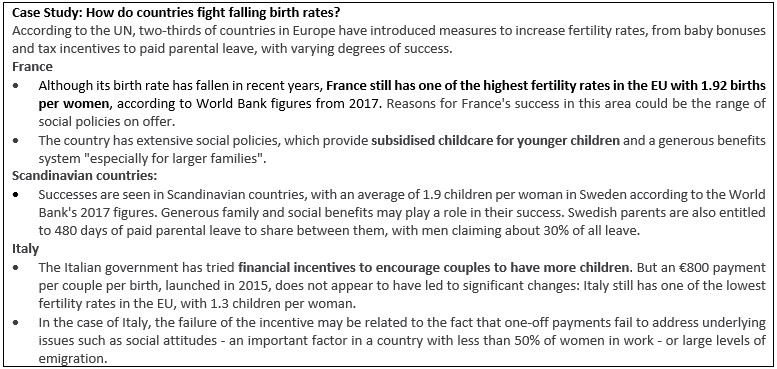
The emerging “silver-economy” can provide opportunities for the health and long-term care sectors. It can be a driver of innovation to help provide high-quality care services in a more efficient way. Digitalisation can provide elderly people with the possibility to independently monitor their health condition. The impact of digital technologies in health and long-term care can be a triple win: improved quality of life, increased efficiency of health and long-term care, market growth and industry development. Research and innovation will be crucial in this regard.
Where it can be used: Paper1 - Population geography (demographic attributes, Causes and consequences of migration) human development index,
Paper2- Cultural setting (demographic attributes)
Regional Disparities in India
WHY IN NEWS?
Recently, the third edition of the SDG India Index and Dashboard 2020–21: Partnerships in the Decade of Action, has been launched by NITI Aayog. It showed the persistent rise of inequality in India.
Status on Regional Inequality in India
- Income inequality:
- The Wealth Index of the National Family Health Survey -4, shows 75% of Bihar’s population fell in lowestquintile for wealth index, while only 2% of Kerala’s population belonged to the same category.
- Political inequality:
- It is aimed to have equality of representation in elected bodies, but only 14% of the total seats in the 2019 Lok Sabha elections are occupied by women.
- Social Inequality:
- As per the 5th Employment-Unemployment Survey conducted by the Labour Bureau, the ratio of the transgender to male LFPR stands lower than the target value of 1.
- Thus there is high social-inequality prevailing in the society.

- Causes of intra regional & inter-regional inequalities in India:
- Perroux’s idea of Growth-pole is at nascent stage in states of Chattisgarh,Nagaland,Mizoram And other states. On the other hand Maharashtra,Gujarat has come-up with well developed growth-centres.These growth-centres bring income-prosperity to these region.
- Lack of Horizontal unity (lack connectivity and integrating factors) and Lack of effective functional linkages for spreading development to other sectors and to surrounding regions of growth poles, leading to islands of development (backwash effect, cumulative causation theory of Gunnar Myrdal) causing poverty and inequalities
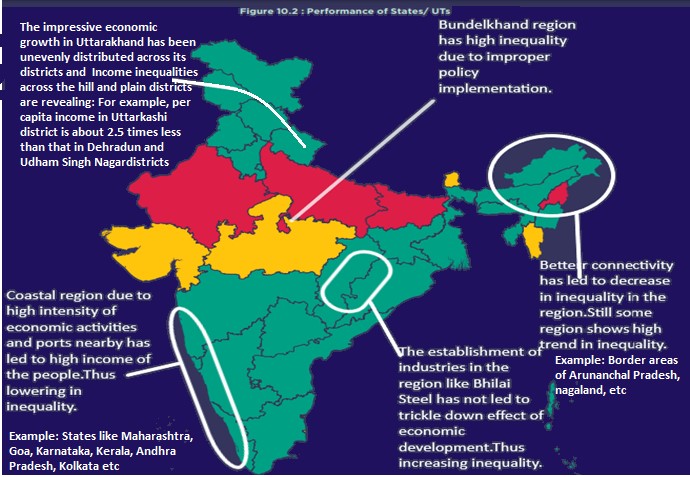
Example: Jukanoli village, in the hill district of Almora, Uttarakhand lack means of proper transportation. Thus low trickle-down effect & contributing to rising inequality.
- Low economic sustainability and viability in agriculture(primary) sector:
A significant fraction of inequality is likely because large numbers of the labour force work in sectors with low productivity. Consider agriculture, which provides 53 per cent jobs, while contributing only 17 per cent to the GDP. This consequently leads to low incomes and cumulates to social inequality.
- Lack of comprehensive development, where regional planner does not seek development of all sectors of economy along with all the segments of society(especially weakers sections like Women, elderly, children etc).
- Measures that can be taken:
- Development of Regional Connectivity
Connectivity to remote areas through multi-mode transportation is required. The expansion of railways in North-east region can be vigorously taken to reduce prevailing inequalities in the region.
Example: Atal Tunnel has been beneficial in regional all-weather connectivity between Lahaul & spiti district to Manali district in Himachal Pradesh.
- Inclusive Growth
Ensure equal opportunity and reduce inequalities of outcome, including by eliminating discriminatory laws, policies and practices and promoting appropriate legislation, policies and action in this regard.
- Conducive Migration policy
According to the Ravenstein Migration law, most of the migration is for economic development. So migration policy can be an enabler in orderly, safe, regular and responsible mobility of people. Thus the implementation of planned and well-managed migration policies is necessary for reducing the inequality.
Where it can be used? Literacy Rate, Sex Ratio, Laws of Migration, Demographic Dividend, Human Development, Concept of Social Well-being, Multi-level Planning, Sustainable Development.
Tags: UPSC, Geography, Optional, Regional Disparities, Paper 2, Migration, Human Development.
Sources:
Regional Disparities in India
WHY IN NEWS?
Recently, the third edition of the SDG India Index and Dashboard 2020–21: Partnerships in the Decade of Action, has been launched by Niti Aayog. It showed the persistent rise of inequality in India.
Status on Regional Inequality in India
- Income inequality:
- The Wealth Index of the National Family Health Survey -4 , shows 75% of Bihar’s population fell in lowestquintile for wealth index, while only 2% of Kerala’s population belonged to the same category.
- Political inequality:
- It is aimed to have equality of representation in elected bodies, but only 14% of the total seats in the 2019 Lok Sabha elections are occupied by women.
- Social Inequality:
- As per the 5th Employment-Unemployment Survey conducted by the Labour Bureau, the ratio of the transgender to male LFPR stands lower than the target value of 1.
- Thus there is high social-inequality prevailing in the society.
- Case Study :- Intra-state inequality is seen in the UT of Jammu & Kashmir.
According to the Survey of India 2011,the highest female worker participation rate is in Jammu (26.62%) whereas Samba district lacks far behind Jammu (with only 11%) in female workforce participation rate.

- Causes of intra regional & inter-regional inequalities in India:
- Perroux’s idea of Growth-pole is at nascent stage in states of Chattisgarh,Nagaland,Mizoram And other states. On the other hand Maharashtra,Gujarat has come-up with well developed growth-centres.These growth-centres bring income-prosperity to these region.
- Lack of Horizontal unity (lack connectivity and integrating factors) and Lack of effective functional linkages for spreading development to other sectors and to surrounding regions of growth poles, leading to islands of development (backwash effect, cumulative causation theory of Gunnar Myrdal) causing poverty and inequalities
Example: Jukanoli village, in the hill district of Almora, Uttarakhand lack means of proper transportation. Thus low trickle-down effect & contributing to rising inequality.
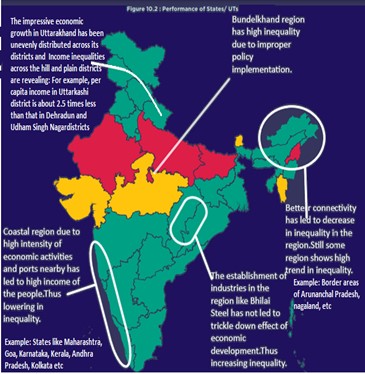
- Low economic sustainability and viability in agriculture(primary) sector:
A significant fraction of inequality is likely because large numbers of the labour force work in sectors with low productivity. Consider agriculture, which provides 53 per cent jobs, while contributing only 17 per cent to the GDP. This consequently leads to low incomes and cumulates to social inequality.
- Lack of comprehensive development, where regional planner does not seek development of all sectors of economy along with all the segments of society(especially weakers sections like Women, elderly, children etc).
- Measures that can be taken:
- Development of Regional Connectivity
Connectivity to remote areas through multi-mode transportation is required. The expansion of railways in North-east region can be vigorously taken to reduce prevailing inequalities in the region.
Example: Atal Tunnel has been beneficial in regional all-weather connectivity between Lahaul & spiti district to Manali district in Himachal Pradesh.
- Inclusive Growth
Ensure equal opportunity and reduce inequalities of outcome, including by eliminating discriminatory laws, policies and practices and promoting appropriate legislation, policies and action in this regard.
- Conducive Migration policy
According to the Ravenstein Migration law, most of the migration is for economic development. So migration policy can be an enabler in orderly, safe, regular and responsible mobility of people. Thus the implementation of planned and well-managed migration policies is necessary for reducing the inequality.
Where it can be used:-Literacy Rate, Sex Ratio, Laws of Migration, Demographic Dividend, Human Development, Concept of Social Well-being, Multi-level Planning, Sustainable Development.
LAKSHADWEEP: India’s Island paradise in turmoil
- Why in news: Draft Lakshadweep Development Authority Regulation, 2021 (LDAR 21) was notified on the official website of the administration.
- Background: It gives sweeping powers to the Administrator to take over land and forcibly relocate people, and proposes harsh punishment to those who resist.
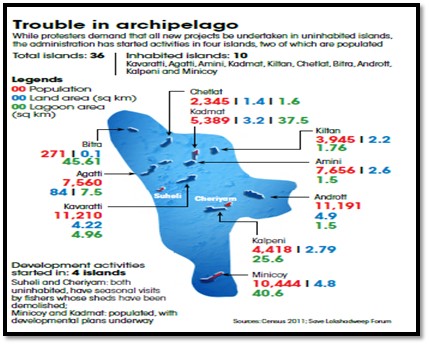

- Challenges arising out of implementation of these regulations :
- Ecologically unsustainable:
- The islands of Lakshadweep are much smaller, biggest islands are no more than 4.5 kilometres across. As coral atolls, their highest elevation is no more than 3 metres above sea level (most of them stand no more than 0.5 metres higher).Diverting this land towards development could only serve to intensify the ecological impacts on the land, as Lakshadweep’s ecology is very fragile.
- Massive-scale tourism, as being mooted by the administration, will introduce unforeseen levels of waste, and managing it is going to pose great challenges to the ecosystem.
- Despite heavy rainfall, these islands are acutely water-stressed and unsustainable tourism push ignores these realities.
- Climate change-related disturbances to Lakshadweep reefs over the past two decades have resulted in atoll reef frameworks being seriously compromised and any stress on the land, lagoon and reef would push Lakshadweep over a critical boundary of ecological decline, from which recovery could be extremely difficult and protracted.
- Proposed plans to occupy the lagoons with floating constructions and solar panels are also misguided, given how vital the lagoons are, especially in the wake of climate disturbances and for local livelihoods.
- Socially un-viable :
- Community participation and the people’s representatives were not consulted before drafting it.
- Local tribal communities, primarily Koya, Malmi and Melacheri, are facing real possibility of becoming the first internally displaced climate refugee in India.
- Transferable development rights to the island have raised the hackles of people who fear they would be forced to migrate en masse.
- No evidence that a two-child policy is effective, instead would lead to rise in sex-selective and unsafe abortions and other social evils. Example: Its population growth rate of 6.1 per cent in 2011(total fertility rate (TFR) of 1.4) does not indicate a need to control population.
- The consumption or sale of beef, is a part of the food and cultural habits of many and above regulations would try to curb such cultural freedom.
- Ecologically unsustainable:
- Other challenges:
-
- Increasing elderly dependency ratio and intensification of the burden of non-communicable diseases, requires significant financial resources to support the elderly and address their healthcare need.
-
- The way forward:
- Effective implementation of V. Ravindran committee recommendation:
- All development projects envisaged in the Integrated Development Plan will be implemented in consultation with the elected local self-government bodies.
- Sensitization of officials and education of the islanders to create awareness about the fragile ecology of the islands and the need for conservation of the corals, lagoons and other eco-systems should be taken up on priority.
- Promotion of niche tourism like crystal clear blue waters and coral reefs etc.
- Local resource based development and renewable energy generation through wind power, tidal power have huge prospects.
- Protecting the fragile ecosystems, coral reefs and the already emaciated natural habitats of the islands is paramount. This could be done by adhering to environmentalism and sustainable development approach.
- Effective implementation of V. Ravindran committee recommendation:
Where it can be used:-
Paper1- Environment Geo(legislation), Regional development
Paper2- Contemporary issues, Regional planning and development
SINKHOLE
Mostly associated with Karst Topography; are closed depressions characteristic of evaporite and carbonate karst landscapes. Sink holes are examples of solution hole. They are formed at the youth stage of Karst Cycle. They do not have external surface drainage, but when it rains the water gets stored at the sinkholes and then flows into the sub-surface. Due to this the rock dissolves and develop spaces and caverns underground. In June 9, 2021 a sinkhole larger than a football field opened up in Santa Maria Zacatepec in Mexico.


CONURBATION
- It describes a built-up area created by the coalescence of once separate urban settlements, initially through ribbon-development along the main inter-urban routes.
- San Francisco bay area (united states), Thetaiheiyo belt (Japan) are examples of conurbations across the world.
- The term Conurbation was coined by Patrick Geddes.
Characteristics of Conurbation
- A continuous built-up area.
- High Population Density.
- Growth of miscellaneous industries.
- Due to cheap transportation Conurbation serve as shopping center for the hinterland surrounding it.
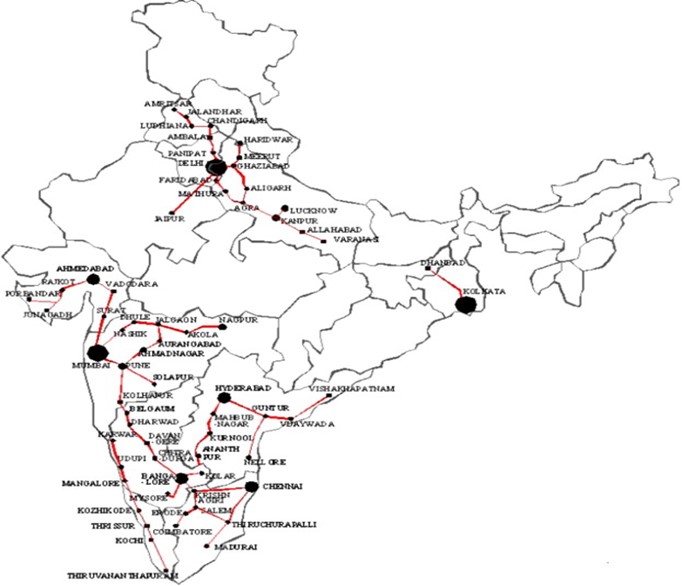
Urban Transport Corridors and Emerging Conurbations of India.
- Delhi conurbation is along NCT of Delhi and the neighbouring contiguous urban areas comprising Gurgaon, Faridabad, Noida, (Greater Noida) and Ghaziabad lying in "Central National Capital Region (CNCR)", a small part of overall NCR. It is expanding towards Panipat, Ambala, Chandigarh.
- The population of this conurbation was estimated 21.7 million in 2011.
PANPLAIN
- The term “panplain” was proposed by H. Crickmay in 1933. Crickmay disagreed with the concept of peneplanation of W.M.Davis and proposed the mechanism of panplanation to account for the development of landforms in later stage of cycle of erosion.
- Panplain is the end product of the cycle of panplanation and is formed due to coalescence of flood plains.
- How are they formed : According to C.H.Crickmay, M.Davis overestimated the rate of wasting of interfluves (water divides). Contrary to this, slower rate of divide wasting combined with more active lateral erosion causes ultimate obliteration of interfluves giving birth to the development of numerous extensive flood plains which ultimately coalesce giving rise to an extensive confluence plain, termed by Crickmay as panplain.
- Characteristics: Panplains are flat and almost even surface which is quite different from the undulating surface of davisinian peneplain.
- Good examples are found in the Carpentaria region of Australia.
- Crickmay’s concept of panplanation could not command wider acceptance by scientific community.

FAROS
- Faro is a Maldivian name given to small atolls that rise in the lagoons of large composite atolls, or, are found on their rims.
- In simpler way, we can say Faros are chain of small atolls having shallow small lagoons.
- An Atoll is a ring of narrow growing corals of horse-shoe shape & crowned with palm tree.
- They are found in Antilles Sea, Red Sea, China Sea, Australian Sea and in many more regions.
- Faros are indeed striking, being perfectly circular reefs, usually less than 3 or 4 km in diameter surrounding a shallow secondary lagoon of depths generally less than 20 m.
- Faros are common in archipelagos of Indian Ocean like Maldives & Mauritius.
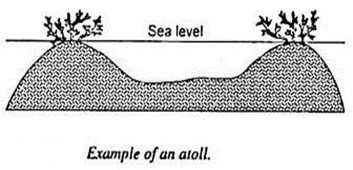

Faro Atoll (Maldives)
GROSS ENVIRONMENTAL PRODUCT (GEP)
Uttarakhand becomes the first state to introduce GEP, as it is one of the most ecologically sensitive regions of India. It is the total value of final ecosystem goods and services supplied to human well-being in a region annually, which can be quantified in terms of biophysical value and monetary value. The main objective of GEP is to make sustainable management viable along with management of ecosystem governance. In future it is expected that GEP will be play a dominant role in policy making.
There are four main pillars of GEP: Air, Water, Soil and Forest
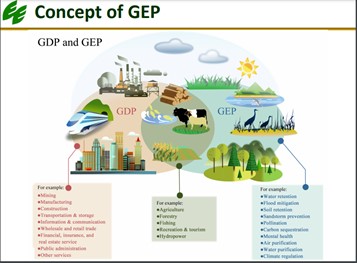
Solar Power Development: Germany
Background:
Despite being amongst the countries with the least sunshine hours, Germany is one of the largest solar power producers in the world. With an installed capacity of over 54 gigawatt (GW) in 2021, the country ranked 4th in the world after leading the charge for several years, according to the International Energy Agency (IEA).
The urgent need of Solar Power for Germany:
- Germany had very limited quantities of oil & gas and has to import 60% of its energy needs.
- Germany decided to curb its greenhouse gas emissions as part of its ambitions towards low-carbon economy.
- Germany decided to shut down all its nuclear power plants by 2022 after Japan’s Fukushima Disaster, 2011.
Thus it is incumbent on Germany to increase the share of Solar Power in its energy mix.

How Germany has become a pioneer in Solar Power development?
- Policy drivers: Number of progressive environmental policies set the stage for its transition into a pioneer of solar power. Examples: Green certification for buildings in 1970s, Eco-tax on fossil based electricity in 2000.
- Use of Feed-in-Tariffs rather than other support mechanisms such as grants, tax incentives & renewable obligations.
- Embracing modern solutions to transform its energy infrastructure (intelligent grid systems, simulation tools, innovative power electronics etc.)
- Decentralization of energy infrastructure.
This can be replicated in India which has an estimated solar power potential of about 750 GW.
Where it can be used:
This case study can be used in topics related to Paper 1 (Sustainable Development, Energy Crisis ) and Paper 2 (Energy Resources, Regional development).
BANGLADESH TOTAL FERTILITY RATE CONTROL
Background: Bangladesh at the time of its independence in 1971, was struggling with high population and rampant poverty. Control of population expansion was the biggest challenge. The challenge to control the TFR was behavioural aspect of the people.
Driving factors for reduction of fertility were:
- Female education- introduction of mass education with government supported reforms that helped expand basic education and improved educational quality and academic standards through higher public expenditure
- Female labour market participation- the recruitment of women as FWAs (Family Welfare Assistants) for the FPP (Family Planning Programme) made the mobility and work of women more socially acceptable. The increase in Female labour force participation rate was achieved through:
- Microfinance movement; which gave them the bargaining power
- The establishment of Multi-Fibre Trade agreement that led to setting up of large export-oriented garment factories that employed mostly women because sewing was traditionally women’s work.
- Reductions in child mortality- extensive changes have occurred in health policy related to maternal health and new-born care .
- Overall economic development due demographic dividend, strong ready-made garment exports, and stable macroeconomic conditions.
- Urbanization - Urbanisation and higher household wealth also were factors associated with lower number of children ever born.
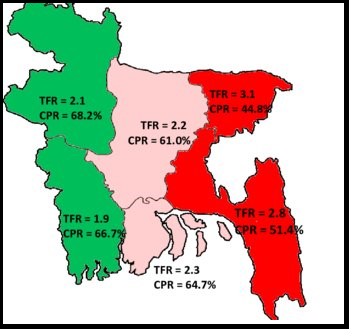
Fig: TFR of Bangladesh 2011
Bangladesh emerged as an outstanding performer on fertility reduction, reducing its TFR from 6.7 children per woman in 1960 to 2.1 children per woman in 2017.

Where it can be used: Paper 1 -Human Geography Section under Demographic attributes, World population problems and policies, social well-being and quality of life.
Kavaratti
|
Kavaratti
|
|
Dehing Patkai Wildlife Sanctuary
|
|
Ranikhet
|
|
Majuli island
|
|
GIFT City
|
|
Mangalore
|
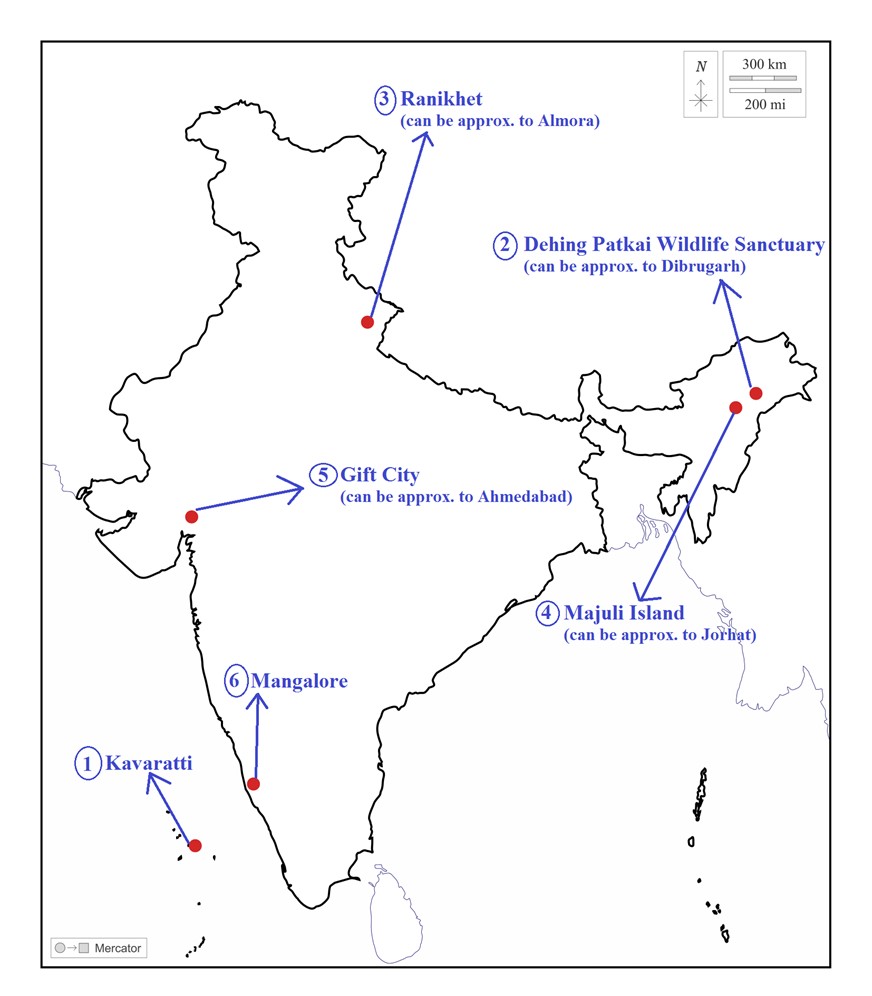
Share the article
Get Latest Updates on Offers, Event dates, and free Mentorship sessions.

Get in touch with our Expert Academic Counsellors 👋
FAQs
Geography Current Affairs focuses on the contemporary issues, events, and developments in the field of geography. It covers recent geographical phenomena, environmental changes, geopolitical shifts, and related news. This differs from regular geography studies which may focus more on foundational concepts, historical contexts, and theoretical frameworks.
Updates are provided regularly to ensure that subscribers stay informed about the latest developments in geography. Typically, updates are provided on a fortnightly basis, depending on the frequency of significant events and changes in the field.
Absolutely. Geography Current Affairs serves as a valuable resource not only for Geography optional but also for GS papers, especially GS Paper 1 (covering Indian Heritage and Culture, History, and Geography of the World and Society) and GS Paper 3 (covering Technology, Economic Development, Biodiversity, Environment, Security, and Disaster Management). It aids in building a holistic understanding of various topics and strengthens answer-writing skills by incorporating contemporary examples and perspectives.
Geography Current Affairs holds immense importance for UPSC preparation, particularly for aspirants opting for Geography optional. It helps candidates stay updated with the latest developments, geographical phenomena, environmental issues, and geopolitical shifts worldwide, aligning them with the dynamic nature of the subject as tested in the UPSC examinations.

